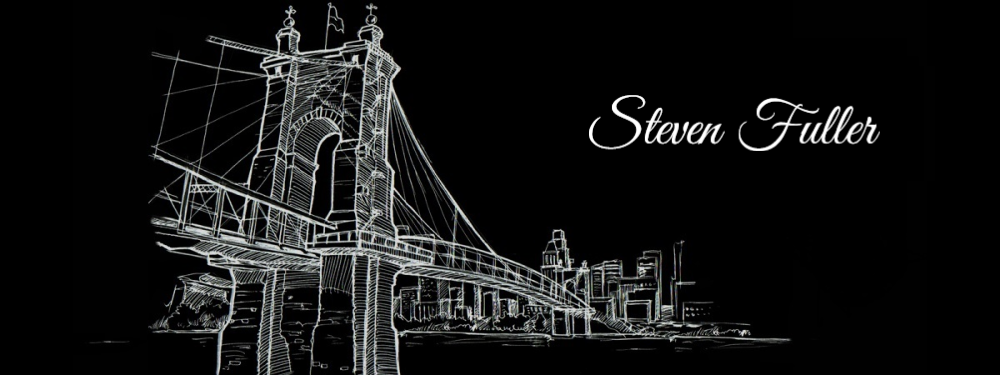The first thing that struck me about Sayler Park was that I could not believe I was still in Cincinnati. Head west, young man, follow the Ohio River, and eventually a small turnoff directs passer-bys to a tiny town that is best known for the tornado of 1974. (That is an actual picture of Sayler Park taken during the tornado. It was one of many that swept over the region in early April, causing major damage and killing three people.)
Called Cincinnati's western gateway, Sayler Park is so far west that I assumed I had crossed over into Indiana along the way. Luckily, after taking the turnoff, I stumbled upon the Parkland Grill, which from what I could tell, is the only bar in Sayler Park. There's a United Dairy Farmers that seems to be the neighborhood's hub, but not much else.
Before I forget and jump into my experience, I need to deliver some bad news to Rob Young (courtesy of the bathroom wall next to the urinal at Parkland Grill):
Oh, Rob. I know this must be difficult to process. I hate to break it to you this way, but I felt like you needed to know. It's only fair. Hang in there, buddy.
Over the past few weeks, I have meet some fascinating people and heard some amazing life stories, but this week's reflection is going to veer in a completely different direction. It's not that Sayler Park isn't filled with interesting residents. From what I could tell, they were everywhere. From the incredibly tan bartender, to the tomboyish woman who jokingly threatened to beat me up if I gave the bartender any trouble, to the couple that looked out of place in the industrial town, to the man who rode into the bar in his wheelchair with an oxygen tank attached to the back (I was really hoping he was going to stay a while, but he picked up food and wheeled back out the front door), Sayler Park overflowed with intrigue.
But I couldn't wedge my way into any conversations. More than almost any other experience I've had (including the Church Experiment), I felt like an outsider.
Price Hill was different. Men who walked into the bar in pairs were talking my ear off five minutes later. Camp Washington was different. Everyone in the bar participated in one large conversation. But Sayler Park seemed to draw a line in the sand, and I was standing on the wrong side.
It's not that they were bad people. After almost two hours of sitting at the bar, the bartender did introduce herself and shook my hand, but it took a long time for her to warm up to me. I tried initiating a few conversations, but before long, a pair a locals would walk in and monopolize her time. The guy sitting closest to me most of the day had his back facing me most of the time while he talked to his group of friends. I tried jumping into the conversation once, but he barely acknowledged me and quickly turned back to his companions.
Perhaps Sayler Park is so isolated that their people skills aren't the best? Perhaps they aren't used to seeing a non-local hanging out at the Parkland Grill? Perhaps I didn't fit in? Perhaps I smelled funny? Perhaps I should have worn pants? There's no way of telling why I couldn't break into the group, but it did get me thinking ...
Churches and bars are eerily similar. Because the Church Experiment so closely resembles this project, it's easy to make comparisons. As I sat there nursing my $1 draught beer (that's right, $1 draughts all day, every day!), I realized people criticize churches for engaging in normal behavior that often goes unnoticed in other social settings.
No matter what we're doing, people naturally form cliques. We want to see and talk to our friends. We feel anxiety about meeting new people, so we often huddle with those most similar to us. It happens at department stores when men congregate near the televisions while their wives shop for clothes; it happens at parties when small groups huddle together in separate corners of the room; it happens in bars when regulars inadvertently shut out newcomers; and it happens in churches when it feels more comfortable to associate with friends rather than visitors. I wonder, then, why we're so critical of churches for making us feel unwelcome, but we give free passes to all other social groups?
Sayler Park is a small community. I got the sense people live there because they want to escape the hustle and bustle of the city, but remarkably, the citizens of Sayler Park are still part of Cincinnati. It's that separation that seems to define this small town. Friendly people, a simpler way of life, and a guardedness whose shell is tough to crack.
I might actually return to Sayler Park sometime soon. Dollar draughts whisper my name in the stillness of night. And breaking into the neighborhood most separated from the rest of Cincinnati could be a fun challenge. Or maybe it will lead to a bar fight. Either way, it sounds like good times.



